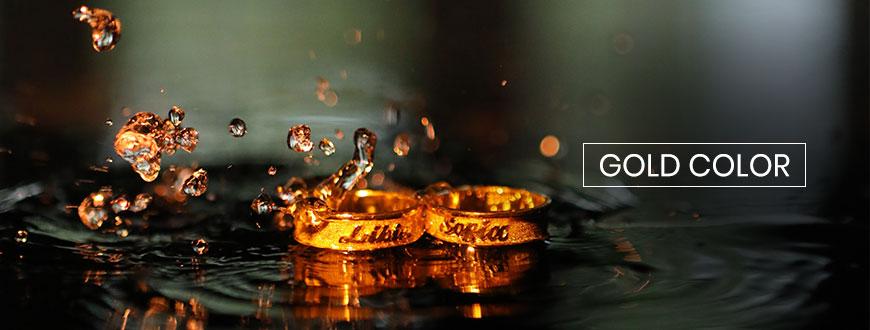Kalyan Wiki

Gold color
Gold ornaments are popular for their bright colour and shiny appearance. Apart from the common yellow colour, gold also comes in various other colour variations. Pure 24 karat gold shows a slightly reddish-yellow colour.
Alloying pure gold with other metals or practising surface treatment processes results in various colour variations, including white, yellow and rose gold. Intermetallic compounds of gold have colours such as purple and blue. The price of ornaments made from such various versions depending upon the purity of gold and the value of alloy metal used.
Yellow gold
We can create bright yellow gold by mixing metals such as zinc, copper and silver with pure gold. For example, the 18k bright yellow gold includes 75% of gold and 25% of copper and silver in equal proportion. If we reduce the silver content and add more copper, the colour yellow will be in a more darker state.
White gold
White gold is an alloy of gold & white metals like nickel, palladium, silver or platinum. It is a good choice for making rings, necklaces and earrings. The ornaments made of white gold appear to be in a slightly greyish-silver colour. White gold is more durable than yellow gold. Some white gold jewels have a layer of rhodium, coated on their surface to provide bright white finish.
Rose/Red/Pink gold
Making an alloy of gold with copper & silver results in rose gold. The colour slightly varies from rose to very light red depending on the percentage of alloy metal. If we use more copper, then the alloy obtained will have a more reddish hue. Copper content increases the durability of the alloy and makes it last for a longer time.
Grey gold
Mixing palladium with gold results in a grey colour. Palladium gold ornaments are a little more greyish than the normal white gold ornaments. We can also create grey gold by adding silver or manganese to pure gold in fixed ratios instead of adding palladium.
Purple gold
This alloy of gold and aluminium is more brittle than other alloys and is rarely used in jewellery. The composition usually contains more than 70% of gold and the rest of aluminium.
Blue gold
Combining gold with gallium or indium results in blue gold. The alloy of gold and indium contains 46% of gold and 54% of indium. The resulting metal is fragile and prone to cracking. The compound of gold and gallium is usually available with 58% of gold content and has a bluish hue, lighter in colour than the former compound.
Black gold
There are various methods by which we can produce black gold. Controlled gold and other surface treatments such as patination and vacuum deposition methods help in the blackening process.
Spangold
Spangold is an alloy of gold, copper and aluminium. Spangold on heat treatment results in a multi-coloured spangled surface. It falls under the category of a shape-memory effect alloy (certain substances' ability to remember an original shape even when it is deformed).
Green gold
Green gold, also known as electrum is a naturally formed alloy of gold and silver. The alloy also contains traces of metals like copper and iron. The metal has a greenish-yellow appearance rather than bright green.
Yellow gold, white gold and rose gold are the most favoured and common choice for making ornaments.







